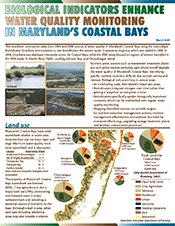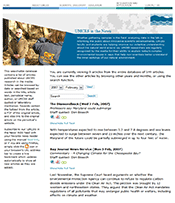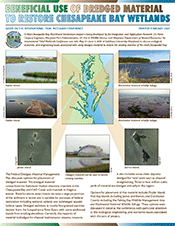New science communication newsletter hardcopy subscription options
In an effort to reduce paper waste, we have added a new topic selection option for hardcopy subscribers of our science communication newsletters. We would appreciate it if existing hardcopy subscribers would please check their subscription details to modify the list of newsletter topics you would like to receive from IAN and EcoCheck, and make sure your postal address details are correct. Thank you.Biological indicators enhance water quality monitoring in Maryland's Coastal Bays newsletter
 Nutrient point sources such as wastewater treatment plants and non-point sources including agricultural runoff degrade the water quality of Maryland's Coastal Bays through excessive nutrient loading. Identifying specific sources is difficult due to their variety and mixture. Biological indicators can identify nitrogen sources, integrate nitrogen from these sources over time, and detect biologically important nutrients. Mapping identified sources can provide targets for nutrient reduction management actions, monitor management effectiveness, and evaluate the need for increased efforts. This newsletter summarizes data from the 2004 and 2006 water quality surveys of Maryland's Coastal Bays, incorporating the macroalgae Gracilaria sp. and the eastern oyster Crassostrea virginica as bioindicators.
Nutrient point sources such as wastewater treatment plants and non-point sources including agricultural runoff degrade the water quality of Maryland's Coastal Bays through excessive nutrient loading. Identifying specific sources is difficult due to their variety and mixture. Biological indicators can identify nitrogen sources, integrate nitrogen from these sources over time, and detect biologically important nutrients. Mapping identified sources can provide targets for nutrient reduction management actions, monitor management effectiveness, and evaluate the need for increased efforts. This newsletter summarizes data from the 2004 and 2006 water quality surveys of Maryland's Coastal Bays, incorporating the macroalgae Gracilaria sp. and the eastern oyster Crassostrea virginica as bioindicators.
UMCES in the News searchable database
 UMCES staff and students are helping to solve environmental problems, and are recognized by the media for their ability to explain complex environmental issues in ways that help non-scientists better understand the issues involved. This database-driven website contains articles published about UMCES research in the media. Articles can be browsed by date or searched by title, article text, periodical name, author, UMCES staff quoted or laboratory affiliation. Subscribe to our 'UMCES in the News' RSS Feed with your favorite news reader so you will automatically receive all new articles as they are published.
UMCES staff and students are helping to solve environmental problems, and are recognized by the media for their ability to explain complex environmental issues in ways that help non-scientists better understand the issues involved. This database-driven website contains articles published about UMCES research in the media. Articles can be browsed by date or searched by title, article text, periodical name, author, UMCES staff quoted or laboratory affiliation. Subscribe to our 'UMCES in the News' RSS Feed with your favorite news reader so you will automatically receive all new articles as they are published.
Beneficial use of dredged material to restore Chesapeake Bay wetlands newsletter
 A Mid-Chesapeake Bay Marshlands Restoration project is being developed by the Integration and Application Network in conjunction with the US Army Corps of Engineers, Maryland Port Administration, US Fish & Wildlife Service, and Maryland Department of Natural Resources. This newsletter discusses the ecological, economic, and engineering issues associated with using dredged material to restore the eroding marshes of the mid-Chesapeake Bay. The purpose of this effort is to develop a study plan that will evaluate the key ecological, economic, and engineering issues associated with a large scale marsh restoration project in Dorchester County.
A Mid-Chesapeake Bay Marshlands Restoration project is being developed by the Integration and Application Network in conjunction with the US Army Corps of Engineers, Maryland Port Administration, US Fish & Wildlife Service, and Maryland Department of Natural Resources. This newsletter discusses the ecological, economic, and engineering issues associated with using dredged material to restore the eroding marshes of the mid-Chesapeake Bay. The purpose of this effort is to develop a study plan that will evaluate the key ecological, economic, and engineering issues associated with a large scale marsh restoration project in Dorchester County.
New IAN contract staff
 Dr. Bill Nuttle expands the IAN network into the Great White North of Ottawa, Canada. Naturally, Bill's first assignment took him to Florida where he joined Bill Dennison and Caroline Wicks to map new directions for NOAA's Center for Sponsored Coastal Ocean Research (CSCOR). The team interviewed over 40 senior scientists and coastal resource managers to identify coastal issues that will drive management decisions in South Florida over the next decade. The CSCOR program seeks to support critical science needed to support ecosystem management. IAN's recommendations will help CSCOR obtain the information needed to respond to this dynamic and changing coastal environment. Bill Nuttle, a Maryland native and University of Maryland graduate has expertise in science applied to the restoration and management of coastal ecosystems (www.eco-hydrology.com). "I always try to look for creative solutions, outside of the box," says Bill, "especially when temperatures are stuck below zero in Ottawa."
Dr. Bill Nuttle expands the IAN network into the Great White North of Ottawa, Canada. Naturally, Bill's first assignment took him to Florida where he joined Bill Dennison and Caroline Wicks to map new directions for NOAA's Center for Sponsored Coastal Ocean Research (CSCOR). The team interviewed over 40 senior scientists and coastal resource managers to identify coastal issues that will drive management decisions in South Florida over the next decade. The CSCOR program seeks to support critical science needed to support ecosystem management. IAN's recommendations will help CSCOR obtain the information needed to respond to this dynamic and changing coastal environment. Bill Nuttle, a Maryland native and University of Maryland graduate has expertise in science applied to the restoration and management of coastal ecosystems (www.eco-hydrology.com). "I always try to look for creative solutions, outside of the box," says Bill, "especially when temperatures are stuck below zero in Ottawa."